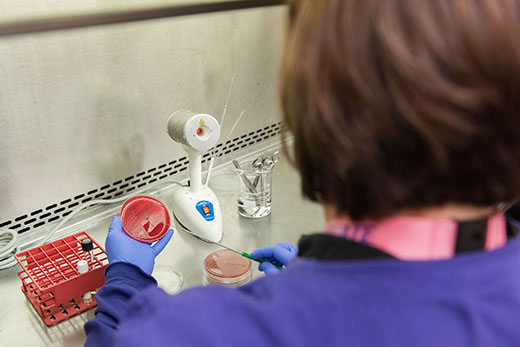Kansas State University pet health expert contributes to USDA's new best-practice recommendations for canine brucellosis
Monday, Nov. 16, 2015

A Kansas State Veterinary Diagnostic Laboratory technician sets up a diagnostic bacterial culture to check for canine brucellosis. | Download this photo.
MANHATTAN — Brucellosis stinks — and in more ways than one – partly as a symptom, but mostly in diagnosis and treatment. It is a disease caused by an intracellular bacterial organism that can infect and pass between several species including humans.
In dogs, the diagnosis and management of canine brucellosis, Brucella canis, has been very problematic, but with help from a pet health expert at the Kansas State Veterinary Diagnostic Laboratory, the U.S. Department of Agriculture's Animal and Plant Health Inspection Service has issued a new set of best practices for veterinarians and kennel operators.
William Fortney, director for small animal outreach for the Veterinary Diagnostic Laboratory, is a widely recognized expert on the immunologic and pathologic aspects of small animal infectious diseases.
"Ever since this disease was first identified, there has always been a lot of confusion among small animal practitioners on how to diagnose it," Fortney said. "While it has historically been thought of as a disease that causes abortions in dogs, it has many clinical signs that are often misinterpreted. This includes symptoms such as testicular swelling, uveitis and spinal arthritis. Veterinarians aren't always aware that they may need to consider the possibility of canine brucellosis."
The Animal and Plant Health Inspection Service recognized there are also public health, population medicine and biosecurity considerations related to canine brucellosis. These aspects created a need to recommend proper protocols for how to manage infected animals, especially in breeding kennels where there can be widespread infections. The report cites a 2011 survey of state public health veterinarians that found at least 28 states have listed canine brucellosis as a reportable disease, but fortunately the incidence in humans is very low. With the adoption of best practices listed in the report, the agency hopes to limit further transmission of canine brucellosis.
In his work at the Veterinary Diagnostic Laboratory, Fortney has helped look at the difficulties in testing for canine brucellosis.
"There are several diagnostic tests available for practitioners who suspect canine brucellosis in their patients," Fortney said. "In the report, we found that several of these tests can potentially produce false positives and false negatives, meaning that multiple diagnostic tests may be needed. Because of the difficulty in detecting canine brucellosis, our report recommends annual testing, particularly in kennel operations."
If pet owners suspect their dog has canine brucellosis, Fortney recommends they talk with their veterinarian to get the best information. To send samples for testing, pet owners are encouraged to work with their veterinarians, who can send samples to the Kansas State Veterinary Diagnostic Laboratory, 1800 Denison Ave., Manhattan, KS 66506. These samples should be shipped in the same manner as all other diagnostic specimens. For more information, contact the laboratory at clientcare@vet.k-state.edu, 866-512-5650 or visit http://www.ksvdl.org.
